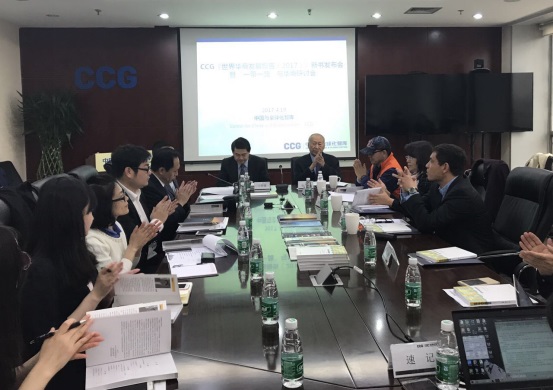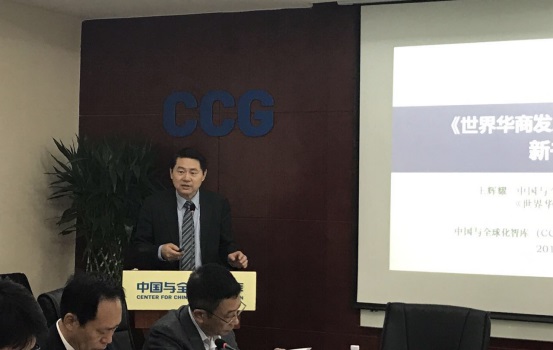By Li Shouen, CCTV.com Commentator & Panview Editor-in-Chief
"Where there are people living, there you can find Chinese." This is a widely spread joke among Chinese. Indeed, it reflects the reality that overseas Chinese are taking up residence in most countries and regions across the world.
The number of overseas Chinese has reached 60 million, out of which around 10 million are new immigrants after China adopted the reform and opening policies in the late 1970s, according to the 2016 Report on Development of World Overseas Chinese Entrepreneurs released Wednesday (April 19) by a Chinese think-tank, Center for China & Globalization (CCG).

The 2016 Report on Development of World Overseas Chinese Entreprenuers, launched by CCG in Beijing Photo/ Li Shouen
The Belt & Road Initiative has seen rising global popularity since it was proposed by Chinese President Xi Jinping more than three years ago.
During a press conference on April 18, Chinese Foreign Minister Wang Yi announced that 28 state leaders will participate in the first Belt & Road International Cooperation Forum to be held here in Beijing from May 14-15.
And other high-ranking officials, scholars, entrepreneurs, financial institutes and media outlets from more than 110 countries, as well as representatives from more than 60 international organizations, will also attend the forum.
Some of the 60 million overseas Chinese have, undoubtedly, found their foothold in all the nations and regions alongside the route of the Belt and Road. And actually, the B&R initiative is more of a concept of cooperation open to all nations and organizations as long as they are willing to participate.
In this sense, all overseas entrepreneurs, together with those native Chinese enterprises that have "gone out" and become international players, can function well as important bridges to link China with their countries of residence under the framework of B&R.
Wang Huiyao, Director of CCG and one of the leading writers of the report, said that there are some new features and trend of overseas Chinese entrepreneur development in recent years.

Wang Huiyao, Director of CCG, introducing the report Photo/ Li Shouen
First, the rapid growth of new Chinese immigrants has reshaped the landscape of world Chinese entrepreneur community, especially the part of investment immigrants has led to a large group of new Chinese entrepreneurs in regions such as North America, Europe and Australia.
But, most large companies of overseas Chinese entrepreneurs are still based in Southeast Asia, topping the list are five Southeast Asian countries: Singapore, Malaysia, Thailand, the Philippines and Indonesia.
Second, overseas Chinese entrepreneurs used to focusing their business in the conventional sectors such as consumer goods manufacturing, retailing, food and beverage, and agriculture. In recent years, however, their business has increasingly expanded into capital and technology-intensive sectors, particularly high-tech industries.
Also, overseas Chinese entrepreneurs are enjoying a gradually improved business environment; some countries and regions are beginning to offer favorable environments for Chinese entrepreneurs.
All these developments are because of the hard work and efforts of overseas Chinese themselves, but they can also be traced back to the support and propelling from their home country, China, which is growing stronger day by day.
The report shows that China's economy, which has maintained a fast growth rate in the past several decades driven by the reform and opening policy, has provided a key engine for overseas Chinese entrepreneurs' development.
And today, China's economic transformation and upgrading, especially the recent Belt & Road Initiative, provides new opportunities for Chinese entrepreneurs, home and overseas.
The initiatives would create tremendous demand for investments in which Chinese entrepreneurs can participate, for example, building industrial parks along the "Belt & Road" route, or operating infrastructure projects to improve transportation.
They are also encouraged by support from Asian Infrastructure Investment Bank (AIIB)'s financing efforts for energy, transportation and other infrastructure projects.
Overseas Chinese entrepreneurs, as a whole, are regarded as the world's third largest economy. So it is a crucial force in China's economic development and the global economy.
Chinese Premier Li Keqiang asked overseas Chinese to help Chinese enterprises go abroad and play an active role in the Belt and Road Initiative and global production capacity cooperation while meeting representatives of the First Global Overseas Chinese Industry and Commerce Convention on July 6, 2015, at the Great Hall of the People in Beijing.
With their advantages, namely, a better understanding of local laws and regulations, native culture and language, and mixing with local people and business circles, overseas Chinese entrepreneurs can play a bigger role in bridging China with their nations of residence and in boosting China's cooperation with those countries within the B&R framework.
(The opinions expressed here do not necessarily reflect the opinions of Panview or CCTV.com)

Panview offers a new window of understanding the world as well as China through the views, opinions, and analysis of experts. We also welcome outside submissions, so feel free to send in your own editorials to "globalopinion@vip.cntv.cn" for consideration.















